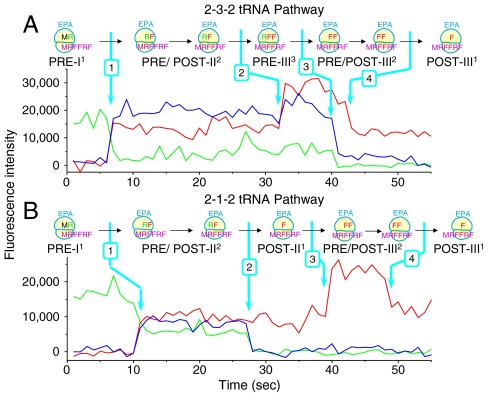Fig. 1.
Two representative single molecule fluorescence traces. (A) The 2-3-2-tRNA pathway and (B) 2-1-2-tRNA pathway. Initiation complexes (ICs) programmed by mRNA MRFFRFYRF (Table S1; single letter amino acid code) were premixed with Arg-tRNAArg(Cy3) TC. The resulting PRE-I1 complex (in which PRE, I, and 1 indicate pretranslocation complex, first translation cycle after formation of the IC, and presence of one labeled tRNA, respectively) was immobilized on a glass cover slip. ALEX fluorescence traces were collected after injecting 10 nM Phe-tRNAPhe(Cy5) TC, 2 μM EF-G and 2 mM GTP to complete the first three elongation cycles (Table S2). Traces were collected at 24 °C. Cy3 fluorescence (green) and sensitized emission of Cy5 (FRET; blue) under 532 nm excitation, alternating with Cy5 fluorescence (red) under 640 nm excitation, were collected and displayed. The TC binding rate constants (8–10 × 106 M-1 s-1) measured here are consistent with in vitro ensemble experiment measurements [5–15 s-1 at 1–10 μM TC (28, 29)]. Formation of different complexes due to tRNA association or dissociation, indicated by changes of Cy3 and Cy5 fluorescence intensity, are marked by arrows. As the contributions of photobleaching to Cy3 and Cy5 disappearance are 0.56% and 1.6%, respectively (Fig. S1), the disappearance of Cy3 and Cy5 fluorescence is due almost entirely to dissociation of labeled tRNAs from the ribosome.

